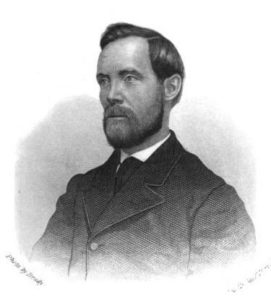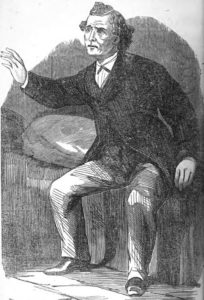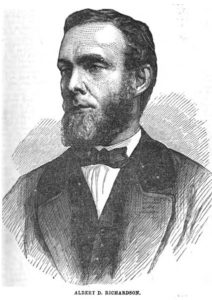The Celebrated McFarland-Richardson Murder Trial in New York City, 1870
Story by Thomas Duke, 1910
“Celebrated Criminal Cases of America”
Part III: Cases East of The Pacific Coast
Daniel McFarland was born in Ireland in 1820, but came to America with his parents at the age of four years.
At the age of twelve, he became an orphan and began to earn his living by working in a harness shop. He was studious and frugal and before he reached his majority he began a course in Dartmouth College.
He studied law and was admitted to the bar, and was afterward appointed professor of elocution at Brandywine College in Delaware.
In 1853, while passing through Manchester, New Hampshire, he met a beautiful and intelligent fifteen-year-old factory girl named Abby Sage, whose father was a poor weaver.
McFarland was then 32 years of age, and four years later, on December 14, 1857, he married this girl.
With reference to the married life of this couple, Mrs. McFarland subsequently made an affidavit substantially as follows:
“At the time of our marriage, Mr. McFarland represented to me that he had a flourishing law practice, brilliant political prospects and property worth .$30,000, but while on our bridal tour he was forced to borrow money in New York to enable us to proceed to Madison, Wisconsin, which was decided upon as our future home.
“We had resided in this town but a short time when he confessed that he had no law practice of any consequence, and that he had devoted himself solely to land speculations, some of which had resulted disastrously.
“In February, 1858, we moved to New York. Three weeks later, he pawned my jewelry to pay the board bill and shortly afterward sent me to my father’s home in New Hampshire.
“A few months later I returned to him, and we rented a cottage in Brooklyn, where our first child was born in December, 1858.
“At first, Mr. McFarland professed for me the most extravagant and passionate devotion, but he soon began to drink heavily and before we were married a year, his breath and body were steaming with vile liquor.
“I implored him to reform, but he cried out: ‘My brain is on fire and liquor makes me sleep.’
“On the day the Southern guns were fired on Fort Sumter, we returned to Madison, but in June, 1861, Mr. McFarland decided that I should become an actress, so he took me to New York to prepare me for that profession.
“By this time, he had become a demon. He would rise in bed, tear the bed clothing into shreds and threaten to kill me. When he became exhausted he would tearfully beg my pardon and go to sleep.
“Through the influence of Hon. Horace Greeley, founder of the New York Tribune, I procured for him a position with one of the Provost marshals.
“In 1864 my third and last child was born.
“In 1865 my husband lost his position and I was forced to make money by giving public readings.
“Through the influence of Mrs. L. G. Calhoun I procured an engagement from Edwin Booth at the Winter Garden, where I made my debut as Nerissa in the ‘Merchant of Venice.’ I also wrote for the Riverside Magazine.
“In January, 1867, we moved to 72 Amity Street, New York.
“At the homes of Mrs. Sinclair and Mrs. Calhoun, I met Mr. Albert D. Richardson (see biography below), who was prominently connected with the New York Tribune, and who was noted for his literary attainments.
“On January 20, he called on me and stated that he was compelled to move from his lodgings, which were almost across the street from ours, and I suggested that he procure apartments from Mrs. Mason, my landlady. I gave him an introduction to her and he moved into the apartments adjoining ours.
“One day, Mr. McFarland came into the house just as Mr. Richardson handed me some manuscript in front of his door. When we entered our apartments, my husband flew into a rage and insisted that an improper intimacy existed between Mr. Richardson and I.
“On February 20, 1867, Mr. McFarland became so violent that I feared he would murder me. The next day I left him permanently and sought shelter at Mrs. Sinclair’s home.
“Mr. Richardson was there when I entered, and he proved to be a friend in need.
“A few days later, he called again and told me that I was the one woman in the world to whom he would entrust the care of his motherless children and concluded by saying that as soon as I was free to marry he would be proud to call me his wife.
“As I considered that the formal separation from Mr. McFarland had the moral effect of a divorce I felt free, and as Mr. Richardson was in every respect the very opposite to the miserable man who had so long tormented me, it was absolutely impossible for me not to love him.
“I was still engaged at the theater, and on the night of March 13, Mr. Richardson accompanied me toward my home. When we had walked but a short distance, Mr. McFarland crept up behind us and fired several shots, one bullet penetrating Mr. Richardson’s thigh.
“In Indiana, on October 31, 1869, I obtained a divorce from Mr. McFarland, and then proceeded to my mother’s home at Medway, Massachusetts.
“On Thanksgiving Day Mr. Richardson had dinner with us and then returned to New York.”
At 5:15 p. m. on November 25, 1869, McFarland, who was then assistant assessor of New York City, entered the counting-room of the New York Tribune, situated at Spruce and Nassau Streets, and took a seat on a stool where he was within full view of several clerks.
Ten minutes later, Richardson entered the office, where upon McFarland instantly arose, whipped out a pistol, shot Richardson in the breast and then fled from the building.
After receiving first aid the wounded man was removed to the Astor House.
McFarland was arrested at 10 p. m. that night in room 31, Westmoreland Hotel, corner Seventeenth Street and Fourth Avenue.
When the arresting officer, Captain A. J. Allaire, informed him of the charge, the prisoner displayed great agitation. After protesting his innocence he said: “It must have been me.”
He was immediately taken before Richardson, who identified him as his assailant.
The former Mrs. McFarland was notified of the tragedy and hastened to the side of her dying lover.
Realizing that his end was near, Richardson expressed a wish that he be married to the woman of his choice, and Mrs. McFarland consenting, the ceremony was performed on November 30, 1869, by Rev. Henry Ward Beecher, Hon. Horace Greeley being one of the witnesses to the solemn proceeding.
Three days later Richardson died and McFarland was immediately charged with murder.
His trial began on April 4, 1870.
Hon. John Graham appeared as leading attorney for the defendant, and in his argument before the jury said in part:
“So sensitive and tender was the defendant’s mental organization that he was incapable of grappling with and bearing the deep sorrows and misfortunes which awaited him.
“His speculations were disastrous, and then it was that the seeds of dissatisfaction first began to be sown. On one occasion this woman said: ‘All I need to make me an elegant lady and popular with the elite of New York is money.’
“When she first met the defendant she was but a poor factory girl, and the brilliant mind which she possesses today has been the fruit of the careful, affectionate and assiduous attentions of my client.
“Through the instrumentality of Richardson an engagement was procured for her at the Winter Garden.
“On February 21, 1867, the defendant came home unexpectedly at 3 p.m., and met her coming out of Richardson’s room. This beautiful woman was then thoroughly corrupted. She had placed before her as temptations the honors of the stage and the society of great men.
“She was then too elegant and too popular for her humble lot and the demon that placed her before all these temptations for which she must pay the price with her soul was Richardson.
“It is claimed that there was something in my client’s actions to justify her conduct. I have shown there was not. But even if there had been it would have been no excuse. Woman never better fulfils her office as a guardian angel than when she is watching over an erring and failing husband. It is at this hour, when he first begins to totter, that her influence should be extended to the uttermost, and her arms be wound around him in a tighter and more affectionate embrace to win him back. Many thousands of husbands have thus in the past been saved, and by the neglect of this, many thousands of husbands have in the past been lost.
“Finally the separation comes. McFarland, now having no home, no child, no hope, no joy, occasionally goes to the Tribune office to see Sam Sinclair, and while there a boy enters and hands him a letter addressed to Mrs. McFarland, which he thought was addressed to Mr. McFarland. He opens it; peruses its contents and finds it is a love letter written by Richardson, who was in Boston, to Mrs. McFarland.
“Finally Richardson openly proclaims his intention to marry this woman if he can obtain a divorce from McFarland for her.”
After discussing the evidence at length, Mr. Graham concluded his argument as follows:
“The evidence produced proves the insanity under which the defendant was laboring at the time of the shooting, a condition of mind super-induced by the agony he endured at the thought of the loss of his home, his wife and his children.
“Upon you, gentlemen of the jury, are riveted the eyes of an anxious public. You are to reflect in your actions the value you place upon your own hearths and the affection with which you regard your own firesides.
“Let those who dare dishonor the husband and the father, who wickedly presume to sap the foundations of his happiness, be admonished in good season of the perilousness of the work in which they are engaged. As a result of your deliberations, may they realize and acknowledge the never-failing justice of the Divine edict that jealousy is the rage of a man and that he will not, cannot and must not spare in the day of his vengeance.”
After deliberating for one hour and fifty-five minutes, the jury returned with a verdict of not guilty.
— End of Duke’s Story —
Albert D. Richardson
From Wikipedia, the free encyclopedia
| Albert Deane Richardson | |

Portrait from The Secret Service (1865). |
|
| Born | October 6, 1833 Franklin, Massachusetts |
| Died | December 2, 1869 (aged 36) New York City, New York |
Albert Deane Richardson (October 6, 1833 – December 2, 1869) was a well-known American journalist, Union spy, and author. Among his works is his noted biography of Ulysses S. Grant.
Contents
- 1 Timeline
- 2 Civil War imprisonment and escape
- 3 A Tragic Affair
- 4 Books
- 5 References
- 6 External links
Timeline
- Born in Franklin, Massachusetts, October 6, 1833
- Obtained first job with newspaper, Pittsburgh Commercial Journal, 1851.
- Married Mary Louise Pease, April 1855.
- Correspondent for the Boston Journal, 1857.
- Edited The Western Mountaineer of Golden City, Colorado, 1860.
- Journalist for the New York Daily Tribune.
- Captured by the Confederates at Vicksburg, May 3, 1863.
- Wife and daughter died.
- Escaped Salisbury, NC, prison, December 18, 1864.
- Shot by Daniel McFarland, March 14, 1867.
- Wrote Through to the Pacific for the New York Tribune, May–June, 1869.
- Shot again by Daniel McFarland, November 25, 1869.
- Married Abby Sage McFarland, November, 1869; marriage performed by Henry Ward Beecher.
- Died December 2, 1869 (McFarland acquitted in a sensational trial).
Civil War imprisonment and escape
Richardson wrote for the New York Tribune owned by Horace Greeley, and traveled to battlefields during the American Civil War to report on the war, often with fellow journalist Junius Henri Browne.
Richardson and Browne were imprisoned for 20 months in seven different prisons, confined successively at Vicksburg, Jackson, Atlanta, Richmond, and Salisbury, North Carolina, prisons. On December 18, 1864, after 20 months of imprisonment, he escaped from Salisbury, along with Browne. They traveled together more than 400 miles through hostile country, and reached the Union lines on January 14, 1865. His list of Union soldiers who died at Salisbury, published in the Tribune, is the only authentic account of their fate.
A Tragic Affair
Richardson was one of the best-known reporters of his age, due to his abilities as a writer and his services (during the American Civil War) as a Union spy. Unfortunately his reputation is recalled as the victim of a homicide that gained considerable notoriety in the Gilded Age. Richardson’s wife and daughter had died during the war, and he subsequently met Abby Sage McFarland, an actress married to one Daniel McFarland. McFarland claimed to be a major businessman and politician, but basically he was a violent husband and alcoholic with connections with Tammany Hall. Richardson and Abby Sage McFarland lived together, their friends and acquaintances (including Horace Greeley) understanding Richardson was protecting the woman he loved while she was trying to get a divorce, something that was not well received generally by the public in the 1860s.
Sage McFarland and Richardson got advice from his friend Vice President Schuyler Colfax on using Indiana divorce laws for the fastest results. McFarland shot and wounded Richardson in March 1867, but the latter recovered. But on November 25, 1869 McFarland shot Richardson in the offices of the New York Tribune in front of the night clerk Daniel Frohman (later a famous Broadway producer). Richarson was fatally shot, but lived for over a week. By this time Abby Sage had gotten her divorce, and Richardson married her at a special bedside marriage performed by the Rev. Henry Ward Beecher.
The trial was a farce, with Tammany connections and dislike for the people who worked at the Tribune being used fairly shamelessly to protect McFarland. He was shown by his defenders to be a defender of the home and hearth against a seducer, as Harry K. Thaw would be shown to be in his 1907 trial for the murder of Stanford White. McFarland was acquitted among cheering crowds. But his ex-wife did not return to him and spent the rest of her life as Abby Richardson, working in the theater as play reader. She died in 1900. McFarland went west. In the words of the criminal historian Edmund Pearson, it did not take him long to drink himself to death.
Looked at today the story has a modern ring because of Abby being the victim of domestic violence. Yet even sixty years later the historian Claude G. Bowers in his partisan history The Tragic Era (1929) showed a mean comfort in the fate of Richardson, and the tarnishing of Beecher, Colfax, and Greeley by the scandal (as though they were responsible, not McFarland).
Journalist Leander Richardson was the son of Albert and Mary Louise.
—###—






